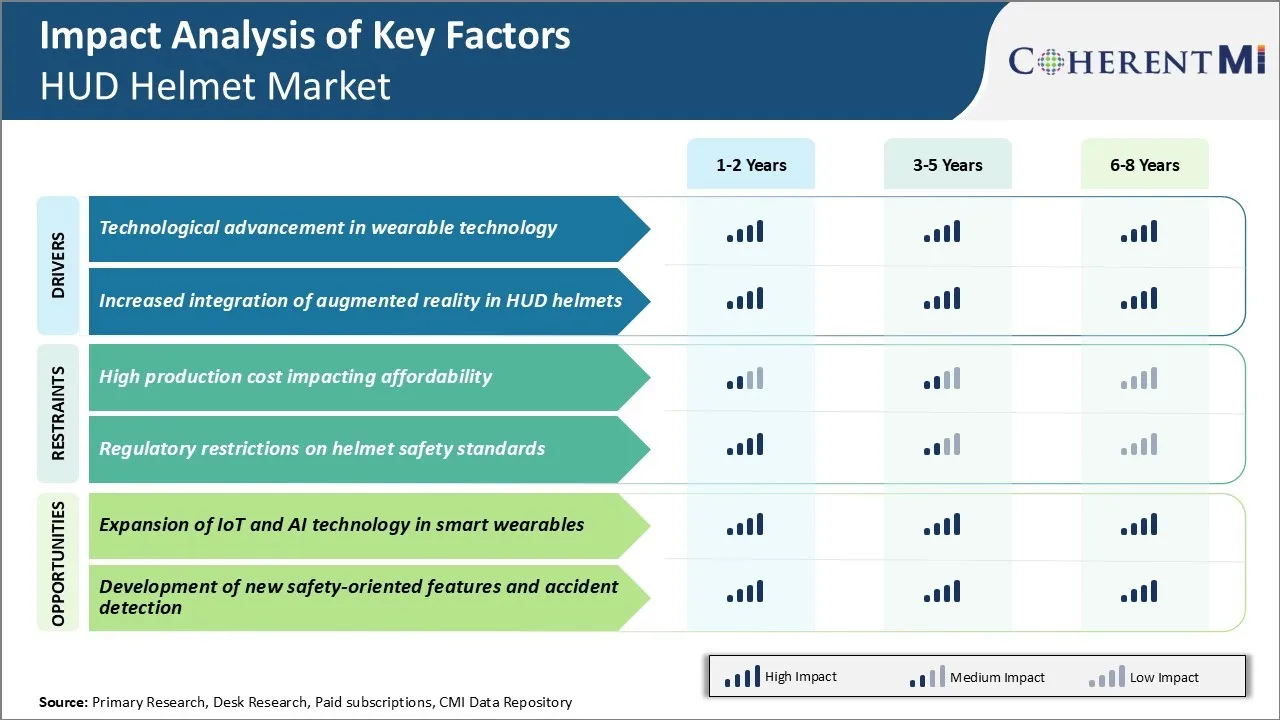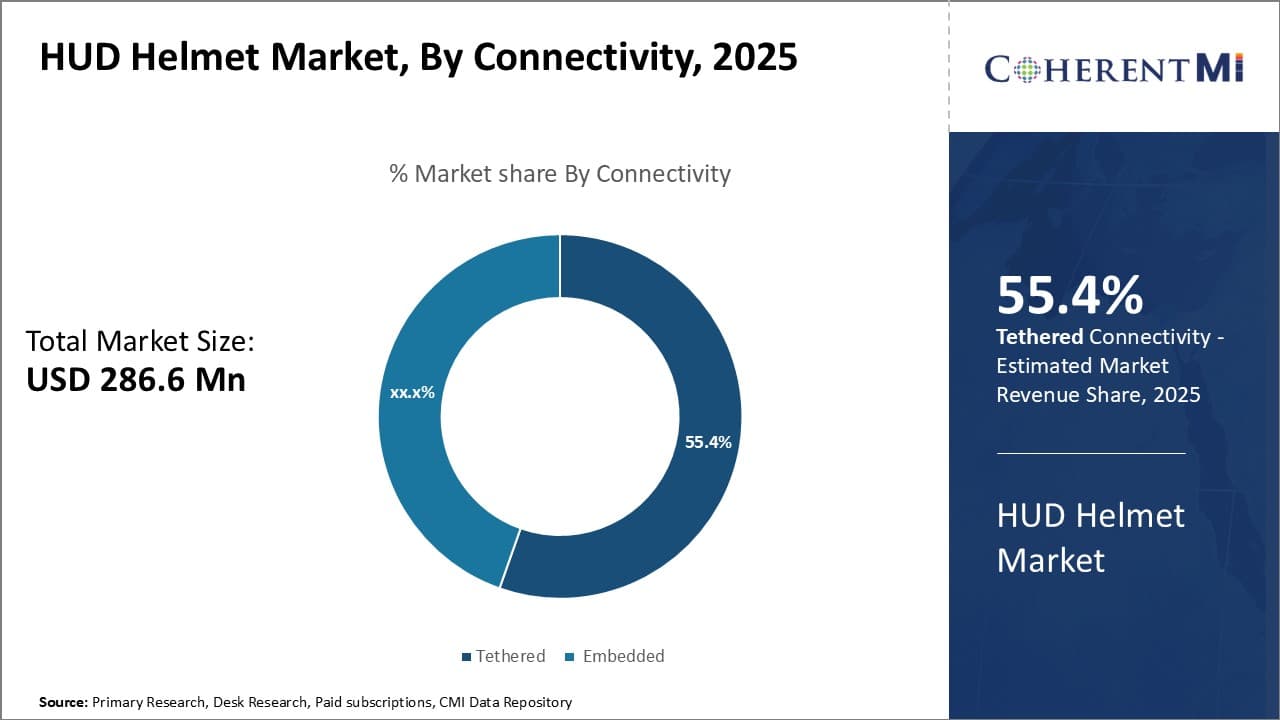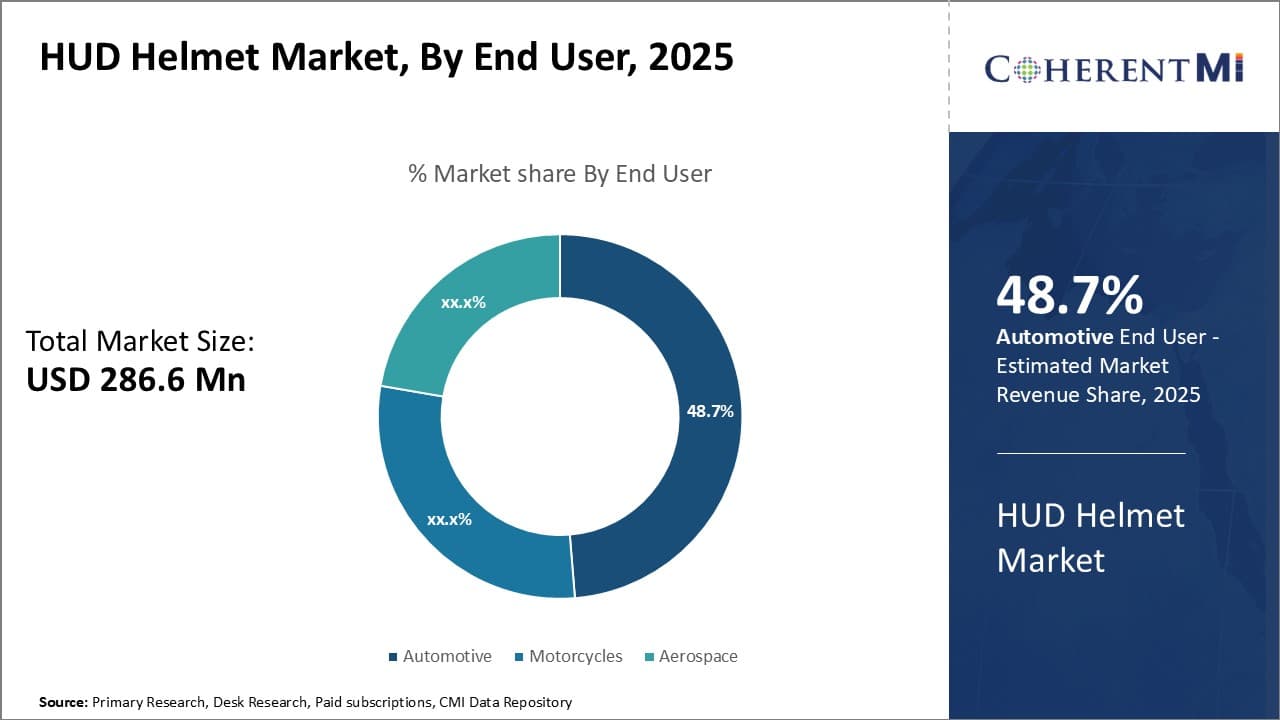

The HUD helmet market is estimated to be valued at USD 286.6 Mn in 2025 and is expected to reach USD 1827.6 Mn by 2032, growing at a compound annual growth rate (CAGR) of 30.3% from 2025 to 2032. The increasing demand for enhanced safety and situational awareness features from bikers and military forces is driving the demand for HUD helmets.
Market Size in USD Mn
CAGR30.3%
| Study Period | 2025-2032 |
| Base Year of Estimation | 2024 |
| CAGR | 30.3% |
| Market Concentration | High |
| Major Players | Dig Lens Inc., NUVIZ Inc., Japan Display Inc., BMW Motorrad, SHOEI ASIA CO., LTD and Among Others |
Market Driver - Technological Advancement in Wearable Technology
As wearable technology continues to make rapid strides, Heads-Up Display (HUD) helmets are certainly benefiting from the increasing ability to integrate more advanced functionality into compact wearable formats. Significant progress has been made in areas such as display technology, processing power, battery life, connectivity and sensors that can all be leveraged by HUD helmets.
Advancements in processing allow HUD helmets to take advantage of improved graphics rendering, image recognition capabilities and response times. With more powerful onboard processors and graphics cards, helmets can offer immersive augmented reality overlaying turn-by-turns on top of the real-world view or even integrating online map data.
Improved connectivity is another boon for HUD helmets, allowing them to take advantage of opportunities like real-time data streaming. For example, integrating 4G LTE connectivity permits two-way communication with other motorcyclists or emergency services in the event help is needed. Data streams from GPS satellites and online maps also enhance the utility of turn-by-turn navigation projected onto the helmet visor.
Such technological advancements are expected to bolster unprecedented growth of the HUD helmet market in the coming years.
Market Driver - Increased Integration of Augmented Reality in HUD Helmets
Augmented reality is an area that promises to truly transform the HUD helmet experience. Today's helmets only provide a basic overlay of limited information like speed or turn-by-turns. However, as AR technology matures, helmets will gain the ability to immerse riders in a much more digitally enriched vision of the road. Sophisticated cameras and live video feeds paired with powerful onboard processors will allow helmets to scan the roadscape in real-time.
As AR technologies continue advancing, the possibilities will grow exponentially. Concepts like advanced object recognition using AI/machine learning, spatial mapping and even sensor fusion techniques promise to deliver AR experiences beyond what can be imagined today. The interface of digitally overlaid information will become more nuanced and fine-tuned based on contextual understanding.
Ultimately, it will deliver an unprecedented immersion for riders where the real and virtual world are seamlessly interwoven through an AR-empowered HUD helmet. While technical challenges remain, the future potential for transformative rider assistance through AR integration is tremendously compelling.
 To learn more about this report, Download Free Sample Copy
To learn more about this report, Download Free Sample Copy
Market Challenge - High Production Cost Impacting Affordability
One of the key challenges faced by the HUD helmet market is related to the high production costs, which consequently impacts the affordability of these helmets for general consumers. Incorporating advanced technological features such as integrated HUD, microprocessors, gesture controls, and connectivity modules significantly adds to the manufacturing expenses.
Further, the use of specialized materials and components optimized for safety and durability standards also drives up the bill of materials. All these factors make HUD helmets significantly more expensive compared to conventional helmets without any integrated technology, which can hinder growth of the HUD helmet market.
For example, some of the premium HUD helmets are priced over $2000, limiting their sales potential. The high costs pose affordability challenges especially in price-sensitive and value-conscious markets. Given that consumers are used to paying $200-500 for regular helmets, the hefty price tags of HUD helmets act as a deterrent for many potential buyers.
Market Opportunity - Expansion of IoT and AI Technology in Smart Wearables
One of the major opportunities for the HUD helmet market is the expanding application of Internet of Things (IoT) and artificial intelligence (AI) capabilities in smart wearable devices.
With constant advancements in microchip technology, the integration of wireless connectivity, sensors, and computing power continues to become more feasible even in helmet form factors. This allows for the development of "smart" HUD helmets that go beyond just integrated displays. Helmets could be upgraded with IoT modules to enable remote monitoring, fleet management and predictive maintenance capabilities.
Furthermore, integrating AI and machine learning algorithms helps create personalized and contextual experiences for riders. Such smart features based on IoT and AI open new growth avenues in the HUD helmet market by enhancing user experience beyond the functionalities of conventional offerings.
Focus on Technology Innovation: A major strategy adopted by players like BIKEDynamics, Skully, and NUVIZ has been continuous investment and development of new technologies. For example, BIKEDynamics launched its RIDE HUD helmet in 2018 with a focus on advanced optical systems.
Partner with Vehicle Manufacturers: Another successful strategy has been partnering with major motorcycle and vehicle OEMs. In 2020, NUVIZ partnered with BMW to integrate its 3D HUD technology directly into BMW Motorrad helmets. Data shows NUVIZ sales grew by 35% in the year following the BMW deal.
Focus on Rider Safety Features: Players like Skully have seen success by focusing on hud features that directly improve rider safety. For example, Skully AR-1 introduced advanced driver assist features like collision detection and hazard alerts presented through the HUD.
Build Brand Recognition: Early leaders in HUD helmet market invested heavily in brand marketing and PR campaigns. BIKEDynamics' "See the Road, Not the HUD" campaign introduced the concept of HUD helmets to a wider audience when they launched.
 To learn more about this report, Download Free Sample Copy
Insights, By Connectivity: Technology Advancement Drives Tethered Segment Growth
To learn more about this report, Download Free Sample Copy
Insights, By Connectivity: Technology Advancement Drives Tethered Segment Growth
The tethered segment holds 55.4% share of the HUD helmet market in 2025, owing to ongoing technology advancement. Tethered helmets are more commonly used as they allow for a wired connection to external devices like smartphones or motorcycles.
Manufacturers are continuously enhancing tethered helmet designs with improved connectivity standards like USB-C that deliver faster charging and support higher resolution displays. The use of advanced cables and high bandwidth chipsets also ensures smooth real-time streaming of navigation directions, call notifications, and music.
A key factor fueling segment growth is the integration of advanced connectivity protocols. Many tethered helmets now support technologies such as WiFi, Bluetooth and proprietary communication standards that expand wireless capabilities. Another major driver is the implementation of user-friendly interfaces. Tethered helmets offer simple and intuitive menus to control diverse functionalities seamlessly via voice commands or physical buttons. This is expected to drive important trends in the HUD helmet market.
 To learn more about this report, Download Free Sample Copy
To learn more about this report, Download Free Sample Copy
Insights, By End User: Automotive Demand Dominates End User Segment
The automotive end user segment holds 48.7% share in the HUD helmet market in 2025. This is driven primarily by growing motorcycle usage. A key factor is rising motorcycle sales volumes globally, especially in developing nations where they serve as affordable personal transportation. Further, motorcycling is gaining popularity as a recreational activity and adventure sport in many countries which stimulates demand. Increasing production of premium and high-performance motorcycles with integrated helmet systems also props up the segment in HUD helmet market.
Wider helmet integration into vehicle designs and technology aids segment growth. Many new motorcycle models include mount points, power ports and wireless connectivity standards optimized for HUD helmets. This delivers seamless pairing of helmet features with motorcycle infotainment, navigation and diagnostic systems. Advanced integration allows functions like turn-by-turn directions, safety alerts and Bluetooth pairing to sync helmet displays with vehicle data. It enhances riders' situational awareness and safety considerably compared to separate systems.
Insights, By Technology: Superior Display Quality Props Up OLED Segment Dominance
Within display technology, OLED helmets account for the bulk of share in HUD helmet market due to their unmatched picture quality. OLED or organic light emitting diode is a novel light emitting technology that is highly suitable for compact near eye applications like HUD helmets.
Manufacturers extensively utilize the unlimited contrast ratio potential of OLED to achieve crisper and more vivid colors in HUD images. The bold, saturated hues and inky blacks improve legibility of small fonts and graphics rendered directly onto riders' field of vision. This is extremely critical for safely scanning navigation instructions or instrument readings while underway. Additionally, OLEDs consume minimal power and are robust enough to withstand vibration demands of helmets without image degradation over time.
Advanced OLED manufacturing expertise also ensures robust and cost-competitive mass production. Given the unparalleled visual experience offered and ongoing technical progress, the OLED segment looks set to retain its dominance. This will dictate growth prospects of the HUD helmet market.
The major players operating in the HUD helmet market include Dig Lens Inc., NUVIZ Inc., Japan Display Inc., BMW Motorrad, SHOEI ASIA CO., LTD, Intelligent Cranium Helmets LLC, JARVISH Inc., BAE Systems, Elbit Systems Ltd., Garmin Ltd., and DENSO Corporation.
Would you like to explore the option of buying individual sections of this report?
Sakshi Suryawanshi is a Research Consultant with 6 years of extensive experience in market research and consulting. She is proficient in market estimation, competitive analysis, and patent analysis. Sakshi excels in identifying market trends and evaluating competitive landscapes to provide actionable insights that drive strategic decision-making. Her expertise helps businesses navigate complex market dynamics and achieve their objectives effectively.
HUD Helmet Market is segmented By Connectivity (Tethered, Embedded), By End User (Automotive (Passen...
HUD Helmet Market
How big is the HUD helmet market?
The HUD helmet market is estimated to be valued at USD 286.6 Mn in 2025 and is expected to reach USD 1,389.1 Mn by 2032.
What are the key factors hampering the growth of the HUD helmet market?
High production cost impacting affordability and regulatory restrictions on helmet safety standards are the major factors hampering the growth of the HUD helmet market.
What are the major factors driving the HUD helmet market growth?
Technological advancement in wearable technology and increased integration of augmented reality in HUD helmets are the major factors driving the HUD helmet market.
Which is the leading connectivity in the HUD helmet market?
The leading connectivity segment is tethered.
Which are the major players operating in the HUD helmet market?
Dig Lens Inc., NUVIZ Inc., Japan Display Inc., BMW Motorrad, SHOEI ASIA CO., LTD, Intelligent Cranium Helmets LLC, JARVISH Inc., BAE Systems, Elbit Systems Ltd., Garmin Ltd., and DENSO Corporation are the major players.
What will be the CAGR of the HUD helmet market?
The CAGR of the HUD helmet market is projected to be 30.3% from 2025-2032.